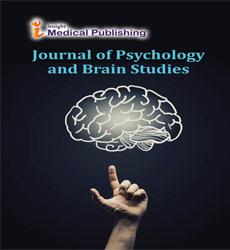Psychophysiology and its Implementation in Neuroscience
Anthony P. Monaco*
Department of Human Genetics, University of Oxford, Oxford, United Kingdom
- *Corresponding Author:
- Anthony P. Monaco
Department of Human Genetics
University of Oxford, Oxford, United Kingdom
E-mail: anthony.monaco@well.ox.ac.uk
Received Date: October 07, 2021; Accepted Date: October 21, 2021; Published Date: October 28, 2021
Citation: Monaco AP (2021) Psychophysiology and its Implementation in Neuroscience. J Psychol Brain Stud Vol.5 No.10:50.
Any research in which the dependent variable (what the researcher measures) is a physiological measure and the independent variable (what the researcher manipulates) is behavioural or mental is characterised as psychophysiology. The majority of the time, the work is done noninvasively with awake human volunteers. Physiological measurements can take numerous forms, including blood flow or neuronal activity in the brain, as well as heart rate variability and eye movements. These metrics can provide information about processes such as emotion and cognition, as well as their interactions. In this approach, physiological measures provide researchers with a very versatile collection of instruments for answering questions about behaviour, cognition, and learning. The study of the interrelationships between the mind, body, and behaviour is known as psychophysiology. It has been proposed that because psychophysiology sits at the intersection of multiple disciplines (e.g., cognitive science, affective neuroscience, and physiology), it may be a "vital cog" in the measurement of brain-behavior relationships, particularly at the intersection of cognition and emotion. This is especially true for addictive behaviours that are emotionally reinforced, as well as addiction treatments that try to improve cognitive control over alcohol and drug use habits.
Psychophysiological methods are a subset of the much broader field of neuroscience approaches. Many neuroscience methods are invasive, such as lesions of neural tissue, injection of neutrally active substances, or electrical stimulation of brain activity. The current survey focuses on non-invasive approaches that are often utilised with human participants. Importantly, while investigating the link between physiology and overt behaviour or mental events, psychophysiology does not try to substitute the latter with the former. Happiness, for example, is a feeling of delightful contentment that is related with many physiological measures, yet those physiological measures are not happiness. Based on self-report, physiology, or overt conduct, we can deduce someone's cognitive or emotional state. Sometimes our primary interest is in inferences about internal events, and other times it is in the physiology itself. Both types of aims are addressed by psychophysiology. Fortunately, there has been a recent paradigm shift away from overly simplified psychophysiological approaches, and knowledge about the specific ways in which bodily processes are embedded within neurophysiological systems has dramatically expanded along with the reawakened neuroscientific interest in oscillatory variability in the brain.
As a result, psychophysiology is emerging as a long-lost relative of neuroscience. The convergence of these disciplines is leading to the creation of "neuropsychophysiological" system theories, which will provide a legal approach to the research and understanding of bodily processes such as heart rate and blood pressure in relation to the neurological system. Functional magnetic resonance imaging (fMRI) is a technique for assessing changes in tissue activity, such as detecting neuronal activity in different parts of the brain during cognition. This technique is based on the concepts of sMRI and takes advantage of the fact that as neurons fire, they consume energy, which must be replaced. Glucose and oxygen, two essential components for energy production, are delivered to the brain via the bloodstream as needed. Hemoglobin, which contains oxygen binding sites, transports oxygen through the blood. The blood-oxygen-level- dependent (BOLD) signal is measured by fMRI as a change in the concentration of oxygenated haemoglobin. This leads to two crucial fMRI facts. First, fMRI monitors blood volume and flow, from which we infer brain activity; fMRI does not directly detect neuronal activity. Second, fMRI data has poor temporal resolution (measurement precision with respect to time); nevertheless, when paired with sMRI, fMRI gives great spatial resolution (the ability to distinguish one object from another in space).
Magnetoencephalography (MEG) is another noninvasive technique for assessing brain activity. The passage of electrical charge (current) linked with cerebral activity generates very weak magnetic fields, which can be detected by sensors positioned near the participant's scalp. The number of sensors utilised ranges from a few to hundreds. Because the magnetic fields of interest are so small, dedicated rooms protected from magnetic fields in the surroundings are required to prevent contamination of the signal being measured. MEG has the same high temporal resolution as EEG.
Open Access Journals
- Aquaculture & Veterinary Science
- Chemistry & Chemical Sciences
- Clinical Sciences
- Engineering
- General Science
- Genetics & Molecular Biology
- Health Care & Nursing
- Immunology & Microbiology
- Materials Science
- Mathematics & Physics
- Medical Sciences
- Neurology & Psychiatry
- Oncology & Cancer Science
- Pharmaceutical Sciences
